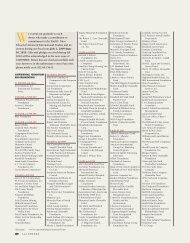Download Current Issue - SAIS
Download Current Issue - SAIS
Download Current Issue - SAIS
You also want an ePaper? Increase the reach of your titles
YUMPU automatically turns print PDFs into web optimized ePapers that Google loves.
percentage of hungry and malnourished<br />
people has declined from 59 percent<br />
in 1992—among the highest in the<br />
world—to about 38 percent in 2007.<br />
One of the conflict drivers concerned<br />
access to agricultural land. Even the<br />
peace settlement brought further conflict<br />
as displaced peoples returned to<br />
their homes and farmlands to find them<br />
occupied by others, while private entrepreneurs<br />
sought to buy up arable land.<br />
The resulting clashes delayed an early<br />
rebirth of agricultural productivity.<br />
However, an interministerial land<br />
commission was set up with FAO assistance<br />
to facilitate a democratic process<br />
to resolve land disputes, and a new land<br />
law was enacted in 1997 after consultation<br />
with official and citizens’ organizations.<br />
This law has been credited with<br />
providing the foundation for sustainable<br />
development and food security in postconflict<br />
Mozambique.<br />
In short, just as violent conflict can<br />
aggravate food insecurity, effective<br />
processes of conflict resolution and<br />
post-conflict institution-building can<br />
help create greater security in matters of<br />
nutrition in the aftermath of long-term<br />
violent conflict, thereby replacing a<br />
vicious cycle with a virtuous one.<br />
Policy Implications<br />
This article focuses on the relationship<br />
between PSCs accompanied by<br />
frequent violence and chronic food<br />
insecurity. Media and the policy community,<br />
however, largely focus their<br />
attention on disasters such as drought,<br />
floods, hurricanes and earthquakes,<br />
and the rapid responses undertaken by<br />
international organizations, national<br />
governments and nongovernmental<br />
organizations, including Oxfam International,<br />
Médecins sans Frontières,<br />
International Rescue Committee,<br />
CARE and UNICEF. But, at best, these<br />
responders provide a bandage to deal<br />
with the immediate effects of the<br />
disaster without taking adequate longrange<br />
actions to alleviate chronic food<br />
insecurity or ongoing violent conflict.<br />
The result is that countries such as<br />
Somalia, which according to the WFP/<br />
FAO report has suffered 15 combined<br />
natural and human-induced disasters<br />
between 1996 and 2010, go through<br />
36 <strong>SAIS</strong>PHERE<br />
the same cycle of disaster on an almost<br />
annual basis without any lasting<br />
improvements.<br />
At worst, humanitarian aid programs,<br />
however well-intended, destroy<br />
local markets and undercut indigenous<br />
agriculture in ways that actually aggravate<br />
long-term food shortages by driving<br />
farmers out of business or into producing<br />
exportable commodities rather<br />
than food for local consumption. Aid<br />
that is unequally distributed in favor of<br />
one group relative to another, captured<br />
by particular groups or warlords or<br />
diverted by political elites for their personal<br />
profit may similarly contribute to<br />
conflict rather than alleviating it.<br />
Policy should therefore be directed<br />
explicitly at promoting long-range local<br />
food production and, at the same time,<br />
assisting in the management and resolution<br />
of local conflicts. Even short-term<br />
aid may be more effective without market<br />
distortion if aid agencies buy local<br />
produce when available.<br />
In addition, the goal of international<br />
assistance must move beyond disaster<br />
relief to offer assistance in food production,<br />
conservation, storage and delivery<br />
to all segments of the population. Reliance<br />
on disaster relief may more easily<br />
attract political backing in developed<br />
countries where the “CNN effect” provides<br />
support for relief in the presence<br />
of widespread, visible famine.<br />
Leaders in developed countries need<br />
to do a better job of educating the public,<br />
media and politicians that the only<br />
way to avoid repeated cycles of food<br />
crises and violent conflict is to engage<br />
in sustained efforts to build institutions<br />
and infrastructure required to break the<br />
cycle. The 2010 WFP/FAO report concludes<br />
with the following valuable recommendation:<br />
“Modalities of assistance<br />
should move beyond the traditional categories<br />
of ‘relief’ and ‘development’ to a<br />
more diversified approach that includes<br />
social protection mechanisms, food<br />
security early-warning systems, disaster<br />
preparedness, environmental protection<br />
and rehabilitation, and building livelihood<br />
resilience.” n<br />
P. Terrence Hopmann is professor of<br />
International Relations and director of<br />
the Conflict Management Program.<br />
China



